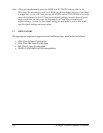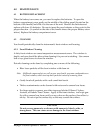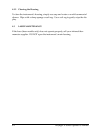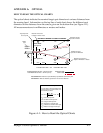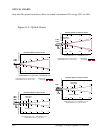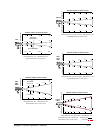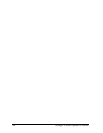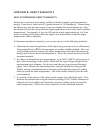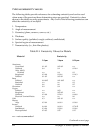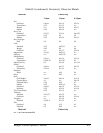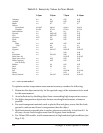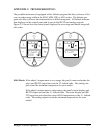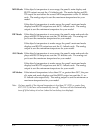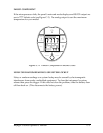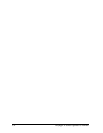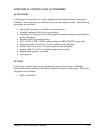
B-2 Raynger 3i Series Operator’s Manual
TYPICAL EMISSIVITY VALUES
The following tables provide references for estimating emissivity and can be used
when none of the previous three determining steps are practical. Emissivity values
shown in the tables are only approximate. Any or all of the following parameters can
affect the emissivity of an object:
1. Temperature
2. Angle of measurement
3. Geometry (plane, concave, convex, etc.)
4. Thickness
5. Surface quality (polished, rough, oxidized, sandblasted)
6. Spectral region of measurement
7. Transmissivity (i.e., thin film plastics)
Table B-1: Emissivity Values for Metals
Material Emissivity
1.0µm 1.6µm 8-14µm
Aluminum
Unoxidized 0.1-0.2 0.02-0.2 n.r.
Oxidized 0.4 0.4 0.2-0.4
Alloy A3003,
Oxidized n.r. 0.4 0.3
Roughened 0.2-0.8 0.2-0.6 0.1-0.3
Polished 0.1-0.2 0.02-0.1 n.r.
Brass
Polished 0.8-0.95 0.01-0.05 n.r.
Burnished n.r. n.r. 0.3
Oxidized 0.6 0.6 0.5
Chromium 0.4 0.4 n.r.
Copper
Polished n.r. 0.03 n.r.
Roughened n.r. 0.05-0.2 n.r.
Oxidized 0.2-0.8 0.2-0.9 0.4-0.8
Electrical Terminal Blocks n.r. n.r. 0.6
Gold 0.3 0.01-0.1 n.r.
Haynes
Alloy 0.5-0.9 0.6-0.9 0.3-0.8
Inconel
Oxidized 0.4-0.9 0.6-0.9 0.7-0.95
Sandblasted 0.3-0.4 0.3-0.6 0.3-0.6
Electropolished 0.2-0.5 0.25 0.15
Continued on next page
n.r. = not recommended



